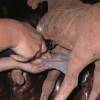 TL is short for "Thermoluminescence" (= Light emittance when heated). A TL-Test is a scientific method of calculating the age of a fired ceramic object, of at least a few hundred years of age. A small sample is taken from the ceramic object and scientifically heated in a laboratory. During this process energy is released as visible light impulses, as a faint "blue light", the amount depending on the time that has passed since the object was last heated to a temperature exceeding 500 centigrades. The amount of light emitted is measured and compared to a scale. The result is technically very reliable within approximately 400 years, and is an accepted standard for verification of the age of low fired pottery. High fired porcelain and stonewares can also be tested but the process of taking the sample needed for the test can in that case destroy the object to be tested.
TL is short for "Thermoluminescence" (= Light emittance when heated). A TL-Test is a scientific method of calculating the age of a fired ceramic object, of at least a few hundred years of age. A small sample is taken from the ceramic object and scientifically heated in a laboratory. During this process energy is released as visible light impulses, as a faint "blue light", the amount depending on the time that has passed since the object was last heated to a temperature exceeding 500 centigrades. The amount of light emitted is measured and compared to a scale. The result is technically very reliable within approximately 400 years, and is an accepted standard for verification of the age of low fired pottery. High fired porcelain and stonewares can also be tested but the process of taking the sample needed for the test can in that case destroy the object to be tested.
It is today possible for fakers to expose newly-made pottery to artificial radiation sources, thus fooling the measurement instruments. But producing fakes with the use of scientific methods calls for expertise on the subject and expensive instruments, and in fact up to now it has been fairly easy to identify this kind of artificial radiation. It is only a question of time, however, until the artificial radiation method is mature for mass production. From that moment onwards, in order to obtain reliable results, it will be necessary to supplement thermoluminescence measurements with further tests.
A TL-test are only to be considered an help in detecting forgeries and determining authenticity in works of art, since there are no substitutes for a trained eye and expertise gained through years of handling objects firsthand. Ideally, expertise and scientific testing should work hand in hand. What one looks for are many things such as style and peculiarities of the art from the periond which migh need an experts experience. One way of defeating a TL test for the fakers are to compose items by potsherds, reassemble them and paint the whole thing over with mud, glue and paint etc.
However on can also scientifically examin the surface encrustations which generally cover the ceramic surface, a method, used at the naked-eye level, as old as archaeology itself. Today it is possible to carry out this test easily using spectrography, which can distinguish with great reliability between artificially produced encrustations using cement, earth and glue from the authentic mineral salts which have formed over centuries underground.
A